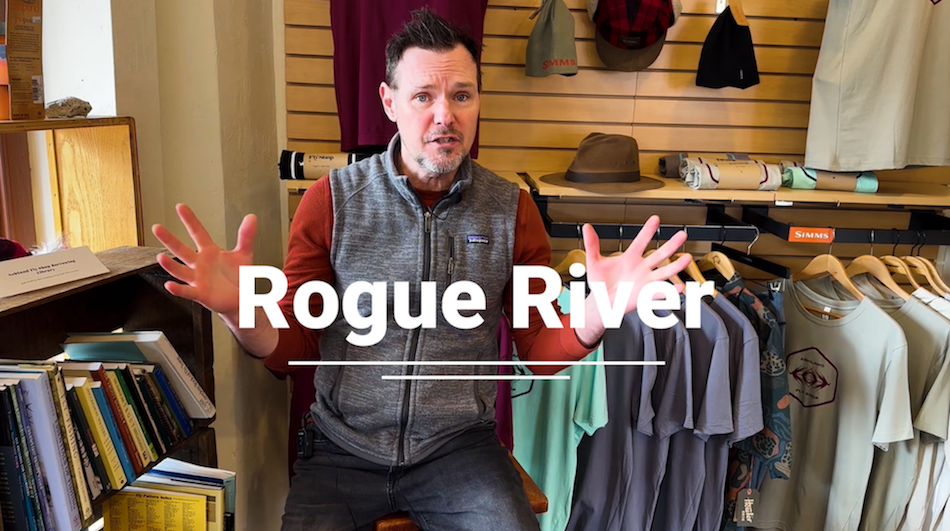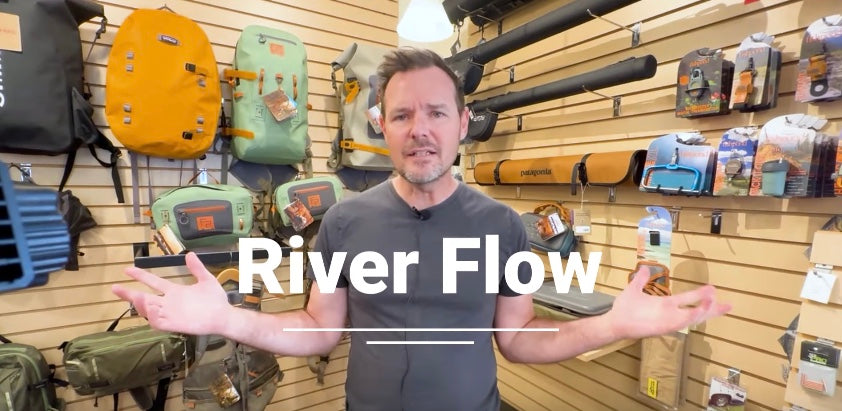Your Cart is Empty
free shipping on all domestic orders over $75
You Asked for It! is a series where we answer specific questions about fly-fishing. Recently we have reached out of social media and offered prizes for the best questions.
This episode was sponsored by Sage and RIO, and the top question winners, as picked and answered by Sage/RIO Marketing Director Russell Miller, are listed below.
Thanks to everyone who participated, and of course, Sage, RIO and Russell Miller!
thelifeofzdavis / Other than streamers what would be a good fly to use on the new trout Spey rods?
(Winner of a Sage Heritage Hoody!)
Trout Spey rods are wonderful streamer fishing tools, in combination with at Trout Max Head and a light set of MOW tips you can really cover a run and mine some beautiful fish out of there. Modest size streamers on the 2-4wt range of rods is one of my favorite ways to fish. But, these rods should not be pigeon holed, it is an absolute blast to fish the 2106 Sage ONE Trout Spey is with softhaclke flies in the riffles. Especially when its summer, I can wet wade, and the bugs are hatching out of the riffles, and water temps are up and are finned friends get real grabby. Nothing gets em like a team of softies on the trout spey. For this application, I prefer to fish a Scandi head for a finer presentation, and, less stripping. Utilizing an intermediate VersiLeader, that is a fish catching setup.
Another way I have fished the 2 and 3 wt ONE Trout Spey rods is to skate dries. We all love doing it for summer steelhead and trout react to the waking fly in the same way. When October Caddis, or your run of the mill caddis this it is a wonderful opportunity to skate dries. Picture soft lighting, greasy tailouts, and the surface of the water dimpling then exploding as you connect with another eager rainbow. Again, I prefer to fish a Scandi head for this application with a long tapered leader or VersiLeader, but the Trout Max and a Floating MOW will get the job done too.
I have yet to do this, but I know that the heavier trout spey in the 4 and 5 wt range, have become popular tools for many bass anglers and smallmouth in particular for fishing divers and poppers. The popularity of the Trout Spey rods in the 4-5wt range in stillwaters has exploded. Overhead casting Outbound Short Heads in the Type3 or 6 have opened up ranges that were for reserved for the best of casters. Not anymore. Just check out what folks are doing on Pyramid lake this season.
So there is always more exploring to be done and just like any pursuit, you will find many different ways to fish.
in2ak / How do I know what length of Skagit head to use for a small switch rod vs a full Spey rod?
(Winner of an AFS and MEGA sticker!)
USE 'MAX SHORTS' ON RODS LESS THAN 12’ IN LENGTH
USE 'SKAGIT MAX' HEADS ON RODS BETWEEN 12’ AND 13’ 6”
USE 'MAX LONGS' ON RODS LONGER THAN 13’6
A simple rule of 2 to 2.5 times the length of your rod
rogueflyfishing / When is the right time, or river conditions to switch from skagit to Scandi and vice versa?
(Winner of a RIO IFlight)
To understand when to switch from a Skagit to a Scandi I think it would be helpful to understand the basic differences between the two lines.
Scandinavian style heads originated in Scandinavia. They are usually shooting heads with long front tapers, and they are very pleasant to cast. The heads are short - usually no longer than three times the length of the rod, thus they are much easier to cast than Traditional Spey lines, and very good for smaller rivers and tight casting situations. The main disadvantages with this type of head is that they don't cast heavy flies and fast sinking tips well, and that there is a lot of fishing time wasted at the end of each cast stripping the line back (if you make along cast!). You can alternate between touch and go casting and sustained anchor style casts. These lines don’t play well with the MOW series of Tips, but prefer the VersiLeaders in either 10’ or 15’.
Skagit heads are short and heavy - even shorter than Scandinavian lines in most cases; working on a ratio of nearly two times the rod length. The real strength of Skagit lines is that they lift weight very easily. Anyone fishing large or heavy flies will find nothing casts these easier than a Skagit line. The MOW Tips work perfectly on the Skagit heads and are best fish with sustained anchor style casting. Also, as Skagit heads are so short, they are the easiest of all Spey line designs to cast, and certainly the best for the tightest of back casting spaces. The disadvantage with Skagit lines is that they don't have the same kind of presentation as the other two types, and tend to be clunkier when they land. Because they are so short, they also have a lot of stripping in after each cast has fished out.
So, when fish one head versus the other?
When I am floating any of our OP rivers or Seattle’s great S rivers, I always have both heads with me. I love my Skagit heads for really doing some heavy lifting work. Big flies, big tips, high banks, and more. They allow me to fish a lot of the water that is not a classic bar that can often times get overlooked. Fishing those overlooked spots is how this head was born. Zero backcast, epic structure, a good pace, enter the Skagit head.
When the anchor drops and we step out to fish a classic bar run, with plenty of back cast room I like to grab my scandi head or Scandi Body head. I really favor this head for efficiency. These are longer heads so I can reduce my time stripping in running line and I can do touch and go casting. Faster casting and less stripping mean I can cover more water faster and hit more spots. These fish great with unweighted flies or light flies, VersiLeaders in 10’ or 15’ in Intermediate – Type 8. The other situation I gravitate towards the Scandi head is when the water is low and clear. The crash of a Skagit head and a big fly can frighten me sometimes and I know the fish are feeling the same way. So when presentation matters, its time for the Scandi.
The choice is personal, but they are both tools that perform different jobs very well.
mike44b Is it still a good idea to swing in the faster water in winter like we do in the summer or should I just focus on the slow deep water with good seams or slots?
(Winner of RIO Leaders)
We answered this question in the video Mike. But what it really comes down to water conditions, regardless of the season. Low, clear water in the winter means steelhead will be hiding in the heavy water or tucked under a ledge. When water is high and off color, look for fish in softer water.
Also, since there were so many good questions, we decided to provide answers to all your questions. So here you go!
edsly42 Best single tip for swinging on the Rogue in winter?
Swinging any river in the winter is all about water conditions. As water conditions change, you have to adapt your tactics accordingly. In general, when the Rogue is high and a little off color, find areas where you can fish slower moving water that's 2-5' deep. As the river clears, you may still find fish on the fringes, but they will hide in deeper water or on structure. Adjust your sink-tip and fly size/color based on the water you fish and water clarity. If you have 2 feet of visibility, you are in the game. Just make sure they can see your fly. Be patient, fish slow, and fish with confidence!
_mr.matt_Where to set your sights when the river (lower D) blows out in the spring? Is the John day as effected by runoff? Best direction to head for finding some trout late March?
The Lower Deschutes and John Day are a little out of our jurisdiction. But, there are certainly other rivers in central Oregon, like the Crooked, that are tailwater fisheries, and may provide more stable or predictable flows in the spring. Spring creeks like the Fall River and Metolious provide constant flows all year, which may be a good alternative. Go get 'em!
sageflyfish How does @jonbonhazlett keep his hair looking so fresh after days on the water steelheading?
2 parts Loon Aquel, 1 part Loon UV Clear Fly Finish (Flow)
alvolt Who asked for this? WHO?
Amanda, chances are you won't see this. Who asked for this? That's a great question. We know you didn't. We're really not sure who asked for it. Needless to say, you're getting it anyway!
s.o._stlhd541 Are Narwhals real? Asking for a friend...
We're not really sure. Still looking for the right fly patterns and tackle!
jimsens What's your personal favorite colors for swinging flies for winter steelhead?
Fly colors are personal, as you already stated in your question. We pick colors based on water conditions, confidence, a feeling, or strictly because all the other colors you tried didn't work. Dark colors are more visible in dirty water, and vice/versa. Staple colors for winter steelhead are black, blue, and pink. Try swimming your fly in the water you're fishing. If it looks good, stick with it for a run or two!
boy_named_crowTips for finding fish in high water. Depth for swinging, weighted or unweighted tips and bugs/ bug size. Nymphing depth and rigging ideas.
There's a great quote "the bigger the river, the shorter the cast". Often in high water fish are holding or moving closer to the bank. As a river clears, they tend to seek the depths, especially if the sun is out or there is pressure on the river. The colder the water, the slower and deeper you need to swing the fly. Water clarity determines fly size/color.
Really the same goes for nymphing. Make sure you find bottom once in a while. Adjust your weight and drop accordingly, until you can make a clean drift without hanging up regularly.
Check out Spey Fishing with Jon: High Water Tactics and some of our other videos on our blog. There's some good info there!
velocity_imagingBest place to land a steelhead on the Rogue?
In a net, of course! Without drawing a map, there's lots of good access on the Rogue. If you live in the Rogue Valley, the water up near the hatchery is the most accessable and productive water available. Get busy!
ebbsforce1Question, why don't I have an AFS sticker?
You should have one! We have them in the shop and online. Better get a couple!
annie_waltz_kubicka I'm a woman fishing by myself and a guy walks in and "low holes" me...and does so knowingly because he looks up river, sees me fishing and waves as he walks in any way. It can be frustrating. Do I put my hands in the air and give him the "what the hell", do I just peacefully accept my fate and his intrusion and know karma will prevail, or shoot him in the knees?
No jury would convict your Annie. You are too sweet and charming. Fire away!
Rob Storie I'm currently using a 7w with an indicator from the bank (wading) and I absolutely hate it. What would you suggest as an alternative while fishing fairly deep water for steelhead.? To clarify, I hate indicator fishing! Throwing a lunky bobber isn't my thing.
Rob it sounds like it's time to get your swing on! With a Spey rod, Skagit line, sink-tip, and weighted fly, you can cover some deeper slots. And of course, it will open up some water that you could never fish with a single hander. Let's chat!
Jamie Montesi Why is one still allowed to harvest wild steelhead in Oregon?
Southern Oregon is the only part of the state where YOU CAN KILL WILD STEELHEAD. Why? Better contact the ODFW. I'm sure they will tell you that we have the healthiest native steelhead populations in the world and that killing a small percentage of them is sustainable. Most likely it comes down to culture, politics, and money.

A February fishing report from Will, covering current and upcoming river and weather conditions on the Rogue, Applegate, Umpqua, and several rivers in northern California!

